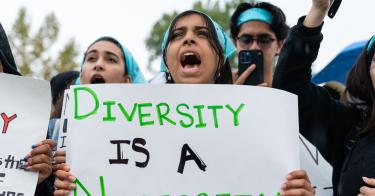James Piereson, a senior fellow at the Manhattan Institute, on Wednesday argued in Newsweek that the recent Stanford Law School tantrum may have “blown up” the Supreme Court cases challenging racial preferences at Harvard and the University of North Carolina.
The Supreme Court has permitted universities to use racial preferences in admissions on the theory that racial diversity has educational benefits. For that reason, Harvard and UNC argue that they should be allowed to continue racially balancing their student bodies because it promotes “greater knowledge,” “tolerance,” and “mutual respect.”
Piereson argues that the shout-down of Judge Kyle Duncan of the 5th U.S. Circuit Court of Appeals by Stanford Law students, abetted by the school’s dean of diversity, equity, and inclusion, Tirien Steinbach, belies that claim.
He says that for some high court justices, “the Stanford episode may have provoked further skepticism about the diversity campaign on campus” and “might have finally settled the case.”
Piereson is right that the obsession over racial diversity has poisoned higher education. We can go further and say that the obsession of liberal pedagogues with diversity of immutable characteristics more generally has killed the spirit of free inquiry and, accordingly, diversity of thought.
But he’s wrong to think that the Stanford tantrum will influence the outcome of the Harvard and UNC cases, for the simple reason that nobody really believes the universities when they argue that racial balancing is good for students.
The conservative justices know that racial discrimination violates the principle that every American is entitled to equal laws and equal treatment. Immutable characteristics provide no moral basis to treat two people differently, and the Constitution’s 14th Amendment embodies that moral precept.
They know, too, that visual diversity is not true diversity—that is, diversity of philosophy, thought, and experience, which does provide educational benefits. And they know that visual diversity is not a proxy for true diversity.
The Stanford tantrum only confirms what they already know.
The poorly concealed secret of the liberal justices is that they know it, too. And so do the universities.
For them, racial preferences have always been about racial balancing. They disguise this, though, because the court has held that racial balancing alone—divorced from the benefits of true diversity—cannot justify race discrimination.
But the diversity defense is a paper veil. At oral argument in the race cases, Justice Sonia Sotomayor tore through it, defending racial preferences on the basis that racial balancing is good. Defenders of racial preferences in the media, in books, and in scholarly articles typically make similar arguments.
The argument that racial balancing is necessary to achieve true diversity appears rarely and almost exclusively in legal briefs. There, tellingly, the connection from racial diversity to true diversity is never established.
Everyone, conservative and liberal alike, knows this.
A long time ago, in another race discrimination case, a judge asked, “Can a court be blind to what must be necessarily known to every intelligent person in the state?” Later, the Supreme Court would answer that, no, “there comes a point where this court should not be ignorant as judges of what we know as men.”
We’ve reached that point in the race cases. And that’s why, ultimately, Piereson is wrong. The Stanford tantrum won’t affect the Harvard and UNC race cases because it tells the justices nothing they don’t already know.
When liberal university administrators say “diversity,” they don’t mean true diversity. They mean visual diversity.
We can and should hope that the justices end racial preferences in those cases because they are both morally wrong and counterproductive. But if the justices preserve preferences, let us hope, at minimum, that they decide to be honest about why they’re doing it.
This piece originally appeared in The Daily Signal




